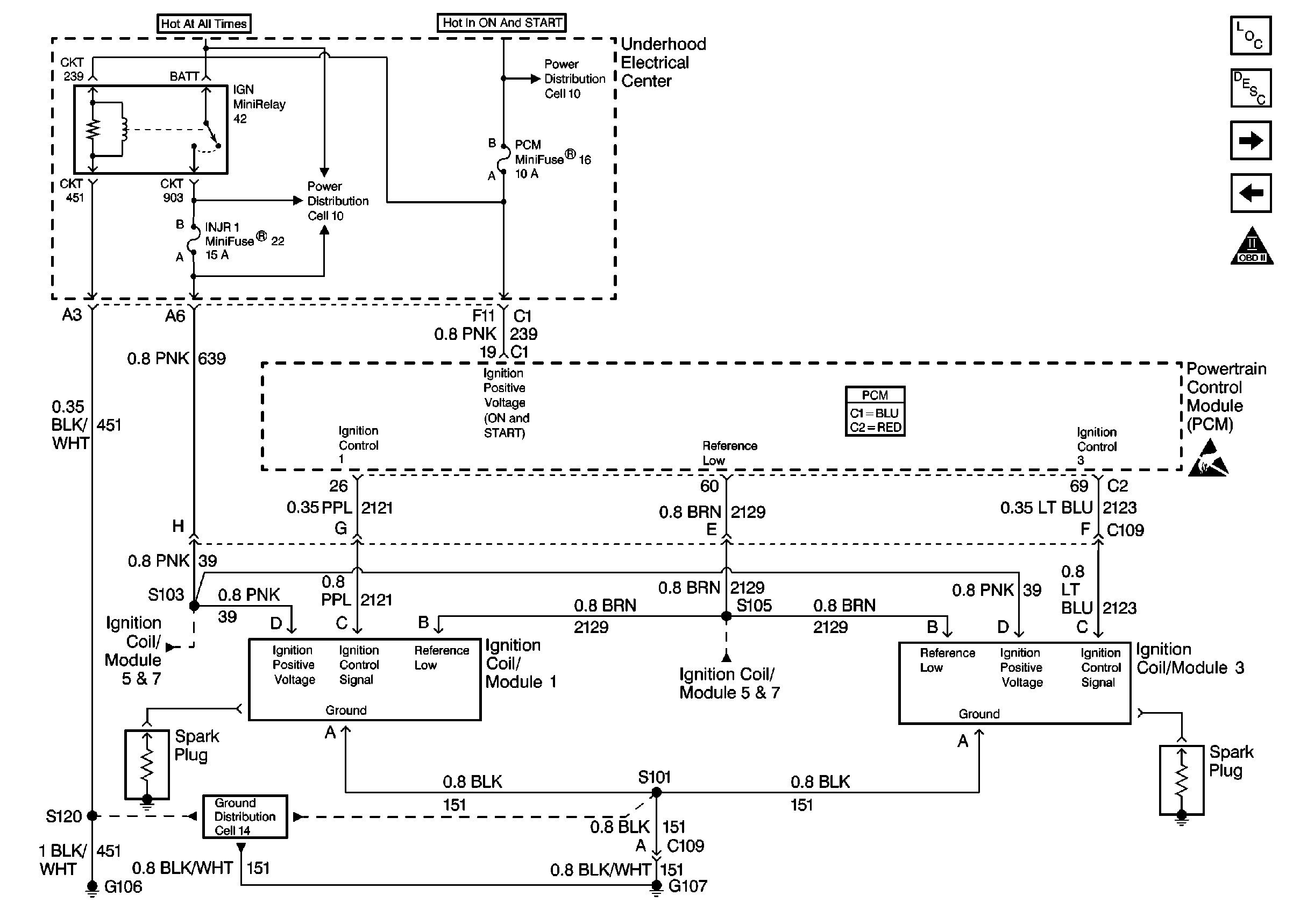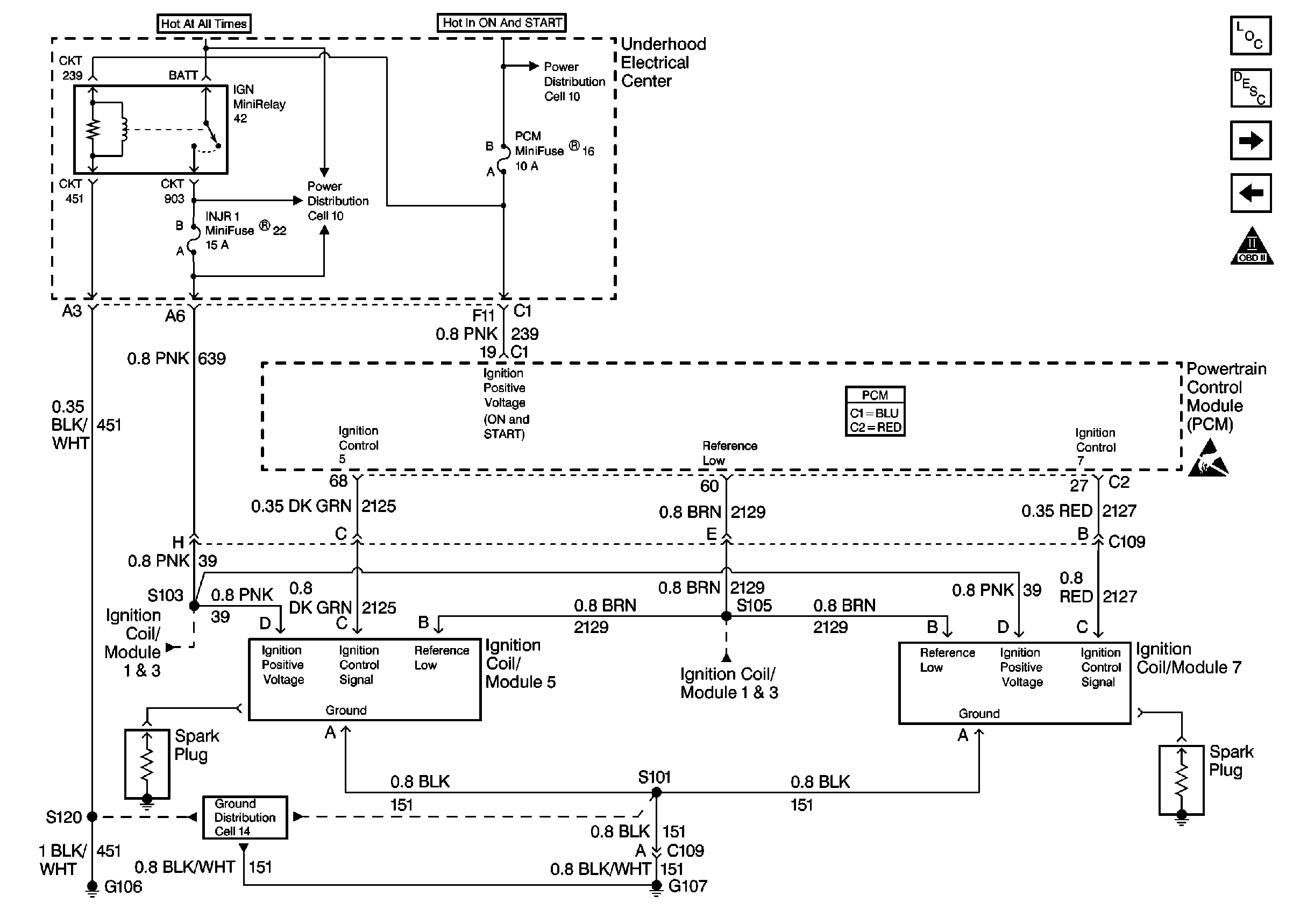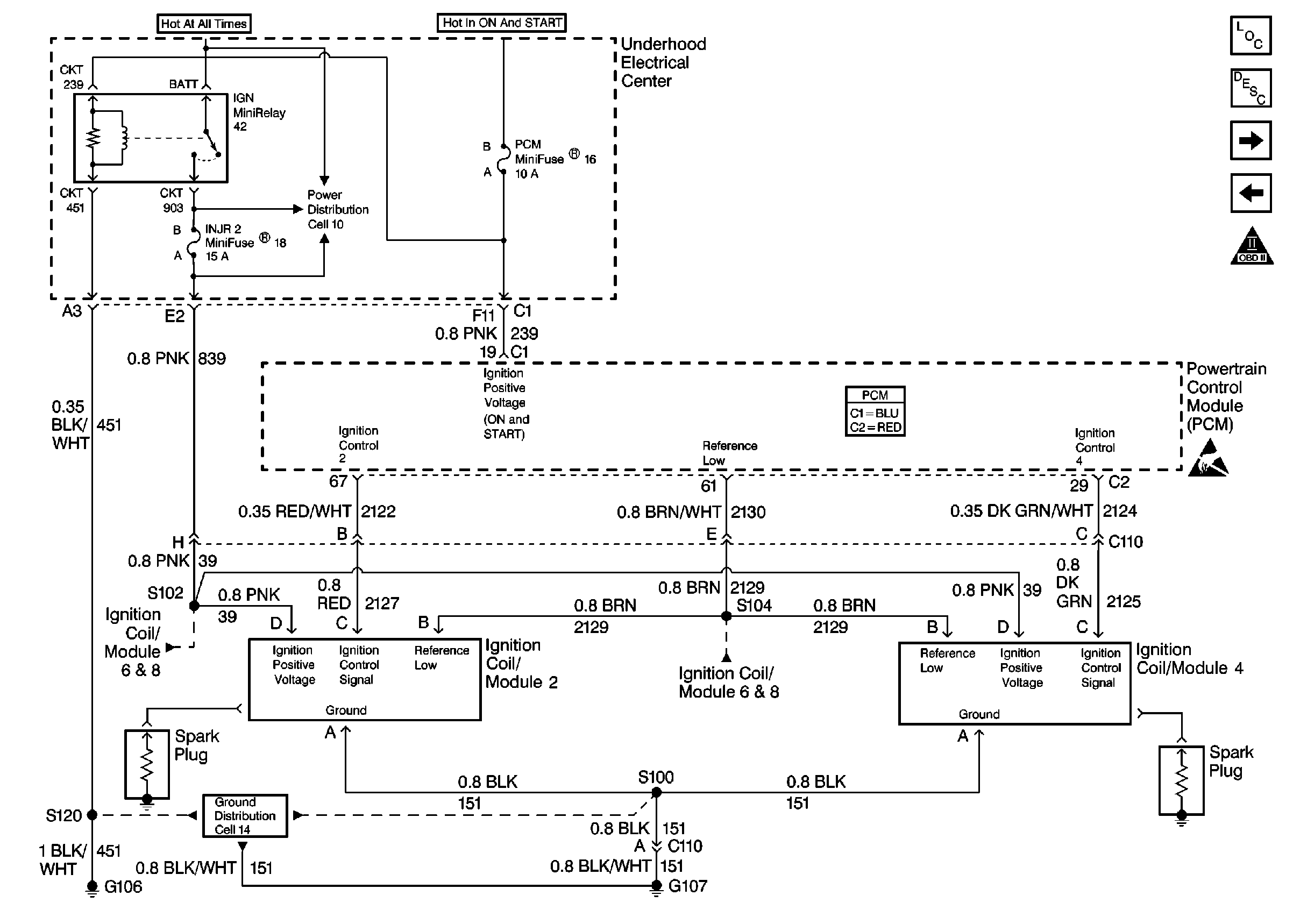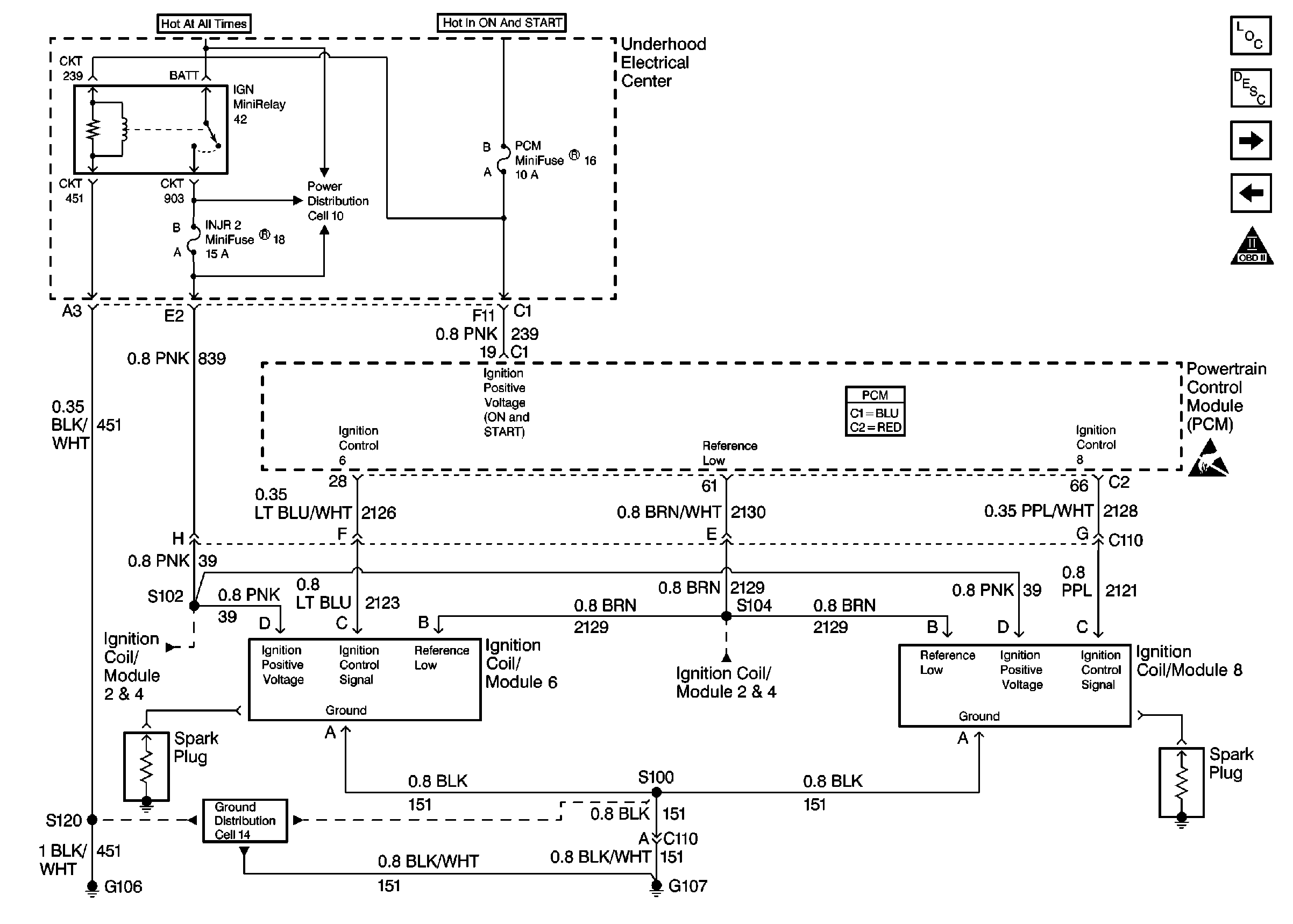Refer to
Cell 20: Ignition Coil/Module Cylinders 1 and 3

,
Cell 20: Ignition Coil/Module Cylinders 5 and 7

,
Cell 20: Ignition Coil/Module Cylinders 2 and 4

, or
Cell 20: Ignition Coil/Module Cylinders 6 and 8

for complete circuit details.
Circuit Description
A crankshaft position (CKP) sensor determines the engine crankshaft position. The sensor is mounted and protrudes into the rear of the engine block. The sensor is near a slotted wheel on the crankshaft. The rotation of the slotted wheel induces a voltage in the sensor. The signal creates the reference pulses needed by the powertrain control module (PCM) to calculate crankshaft speed and position. These signals trigger the correct ignition coil to fire, at the correct time.
The ignition system on this engine uses an individual ignition coil/module for each cylinder. The PCM controls the ignition system operation. There are 8 ignition control (IC) circuits, one per cylinder, that connect the PCM with the ignition coil/modules. Each ignition coil/module has a power feed, a chassis ground circuit, a signal circuit and a reference low circuit. The PCM calculates the ignition sequence and timing of the spark plugs.
Diagnostic Aids
Important:
• Remove any debris from the PCM connector surfaces before servicing
the PCM. Inspect the PCM connector gaskets when diagnosing/replacing
the modules. Ensure that the gaskets are installed correctly. The
gaskets prevent contaminate intrusion into the PCM. • For any test that requires probing the PCM or a component
harness connector, use the Connector Test Adapter Kit J 35616
. Using this kit prevents damage
to the harness/component terminals. Refer to
Using Connector Test Adapters
in Wiring Systems.
| • | The following may cause an intermittent: |
| - | Poor connections |
| - | Refer to Testing for Intermittent Conditions and Poor Connections in Wiring Systems. |
| - | Corrosion |
| - | Mis-routed harness |
| - | Rubbed through wire insulation |
| - | Broken wire inside the insulation |
| • | For an intermittent condition, refer to Symptoms . |
Test Description
The numbers below refer to the step numbers on the diagnostic table.
-
Monitoring the misfire current counters determines if a fault is present.
-
A good indication that the fuse is open is all the misfire current counters are incrementing on one side of the engine. Inspect the ignition feed circuit for a grounded circuit.
-
If the fuse is open and no problem can be found with the ignition coil/module circuits, inspect the injector circuits for being grounded. The INJR1 fuse and INJR2 fuse feed the ignition coil/module circuits and injector circuits.
Step | Action | Values | Yes | No |
|---|---|---|---|---|
1 | Did you perform the Powertrain On-Board Diagnostic (OBD) System Check? | -- | ||
2 | Verify whether DTCs P0335, P0336 or P0351-P0358 are set. Are any of the above DTCs set? | -- | Go to the applicable DTC table | |
|
Important: This table assumes that there are no injector circuit malfunctions or mechanical malfunctions. If you were not sent here from DTC P0300, refer to DTC P0300 Engine Misfire Detected before proceeding with this table.
Are any of the Misfire Current Counters incrementing? | -- | For intermittents, go to Diagnostic Aids | ||
Are the misfire current counters incrementing for all cylinders on one bank of the engine? | -- | |||
5 |
Does the test lamp illuminate? | -- | ||
6 | Using the test lamp probe the ignition feed circuit at the ignition coil/module electrical connector to the ignition coil/module ground circuit. Does the test lamp illuminate? | -- | ||
7 | Using the test lamp probe the ignition feed circuit at the ignition coil/module electrical connector to the ignition coil/module reference low circuit. Does the test lamp illuminate? | -- | ||
Did you find a condition and correct it? | -- | System OK | ||
9 | Repair the open in the ignition feed circuit between the fuse block and the splice. Refer to Wiring Repairs in Wiring Systems. Is the action complete? | -- | System OK | -- |
10 |
Does the test lamp illuminate? | -- | ||
11 | Repair the open circuit between the splice and the ignition coil/module connector. Refer to Wiring Repairs in Wiring Systems. Is the action complete? | -- | System OK | -- |
12 | Repair the open ignition feed circuit between the fuse block (open fuse) and splice. Refer to Wiring Repairs in Wiring Systems. Is the action complete? | -- | System OK | -- |
13 |
Does the test lamp illuminate? | -- | ||
14 |
Did you find a condition and correct it? | -- | System OK | |
15 | Repair the open ground circuit between the main 8-way connector and the ignition coil/module connector. Refer to Wiring Repairs in Wiring Systems. Is the action complete? | -- | System OK | -- |
16 | Repair the open ground circuit between the ground and the main 8-way connector. Refer to Wiring Repairs in Wiring Systems. Is the action complete? | -- | System OK | -- |
17 |
Does the test lamp illuminate? | -- | ||
18 |
Did you find a condition and correct it? | -- | System OK | |
19 | Repair the open reference low circuit between the main 8-way connector and the ignition coil/module connector. Refer to Wiring Repairs in Wiring Systems. Is the action complete? | -- | System OK | -- |
20 | Repair the open reference low circuit between the PCM and the splice. Refer to Wiring Repairs in Wiring Systems. Is the action complete? | -- | System OK | -- |
21 |
Did you find a condition and correct it? | -- | System OK | |
22 | Replace the ignition coil/module. Refer to Ignition Coil Replacement in Engine Electrical. Is the action complete? | -- | System OK
| -- |
